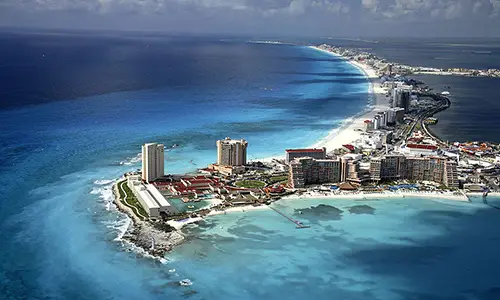1. Cancun’s Name
As a coastal city, Cancun is a Tourist Island in Mexico that has earned the name ‘Mexican Caribbean’. Before the city acquired the name Cancun, it went by the name “Ekab” which means Black Earth. The current name means “snakes nest” or “nest of serpents” in Mayan language.
2. Cancun’s Climate
The hottest month in Cancun is June when temperatures rise to 28° Celsius and the coldest is January at 23° Celsius. September and October are the rainiest months with an average of 270mm of rain. July is the best month to take a swim when the average sea temperature is 29° Celsius. The weather is most desirable from November to April, with pleasantly warm days and refreshing evenings. Summer thunderstorms are usually brief but occur in many cases.
3. Cancun Statistics
Cancun receives over 4 million visitors yearly, with over 1/3 of Mexico’s tourism revenue generated by this island. The island hosts over 46,000 weddings per year. There are over 240 sunny days in Cancun with an average annual temperature of 80 degrees. The official currency is the Mexican Peso. Initially, Cancun had only three residents. The island today has over 700,000 residents.
4. Cancun Beaches
Cancun consists of beaches that have white sand. The white sand are formed by crushed corals. The sand is cool and is not hot to the touch. Hurricane Wilma caused damage and erosion of the Island. A beach restoration project worth 70 million dollars was put forth to correct the damage. 6.1 cubic meters of sand was used to rebuild the beaches. The project added 7 miles of coast between 40-70 yards wide. Cancun has the safest beaches located on the north side of the causeway leading to Cancun City.
5. Cancun’s busy Airports
In Mexico, the second busiest airport is the Cancun International Airport. In 2009, over 11 million foreign visitors travelled to Cancun by air. Cancun’s airport has two runways that operate simultaneously. This airport has the tallest tower in Latin America. The airport has the most international traffic in Latin America. Cancun’s airport serves an estimated 800,000 passengers per month who pass through its portals.
6. Home of the largest Reef Systems in the World
The great Maya Barrier Reef in Cancun is the second largest coral reef in the world. Australia’s Great Barrier Reef is the largest. Cancun’s barrier reef is a great region for scuba diving.
7. Hotel zone in Cancun
The construction of this zone commenced in 1970 with the first hotels on this island opening in 1974. The region takes the shape of the number 7 and is bordered by the Caribbean ocean on the east side. It is separated from the mainland by the freshwater Laguna Nichupte on the west. The bridges on both sides link it to the mainland. Cancun has over 140 hotels that have over 270,000 hotel rooms and over 350 restaurants today.
8. Beaches in Cancun are Public
Cancun has 14 miles of white-sand beaches, but they are all public. Though hotels have some of their properties like umbrellas and chairs on the beaches for their guests, the beaches are open for everyone.
9. Home to the largest Underwater Caves
Cancun is home to 3 of the world’s largest underwater caves in the world. The caves include Dos Ojos, which is 57.7 kilometers long, Nohock Na Choch, which is 61 kilometers long and Ox Bel Ha, which is 146.7 kilometers long. These caves found in the Riveria Maya region are top tourist attractions.
10. Cancun’s Districts
The island is divided into three districts that include The Downtown Cancun, The Ecological Reserve and the Hotel Zone. Downtown Cancun offers a cost effective place to shop and learn about the locals. The Ecological Reserve hosts Mexico’s largest ecosystems and the Hotel Zone offers beaches as well as places to shop.









Leave a Reply